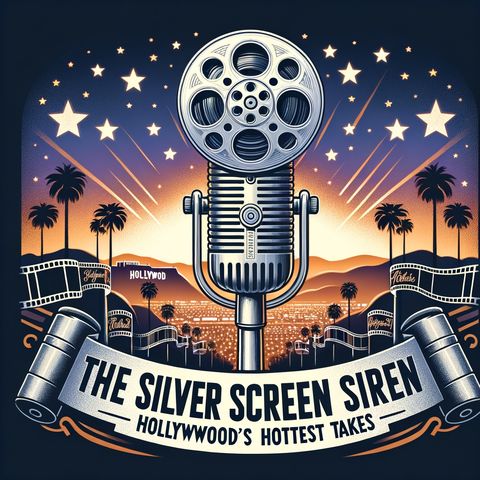"Behind the Glitz: Candid Conversations with Tinseltown's Biggest Stars"

Download and listen anywhere
Download your favorite episodes and enjoy them, wherever you are! Sign up or log in now to access offline listening.
"Behind the Glitz: Candid Conversations with Tinseltown's Biggest Stars"
This is an automatically generated transcript. Please note that complete accuracy is not guaranteed.
Description
As I walk through the gilded halls of Hollywood's golden age, I can't help but marvel at how the silver screen has shaped our cultural landscape for over a century....
show moreThe term "silver screen" itself has an fascinating origin, dating back to the early days of cinema when actual metallic silver particles were embedded in the projection screens to enhance reflection and create a more luminous image. Those early projection surfaces quite literally sparkled, lending an ethereal quality to the moving pictures that danced across them.
I've spent countless hours researching the quirky behind-the-scenes stories that make Hollywood such an endlessly fascinating subject. Take, for instance, the fact that in the 1920s, MGM employed a "moral ombudsman" whose sole job was to ensure that married actors in love scenes weren't too convincing, lest audiences suspect real-life impropriety. The Hayes Code era that followed brought even stricter regulations - married couples couldn't even share a bed on screen, leading to the famous twin bed setups we still laugh about today.
The transformation of Hollywood from a dusty Los Angeles suburb to the entertainment capital of the world never fails to amaze me. What started as a way for movie makers to escape Thomas Edison's film patents on the East Coast became the stuff of legend. I often think about how those early pioneers would react to seeing their modest film lots transformed into today's sprawling studio complexes.
Walking through the Warner Bros. lot recently, I was reminded of how some of the most iconic moments in film history happened completely by accident. The famous line "Here's looking at you, kid" from Casablanca was actually Humphrey Bogart's personal phrase that he used while teaching Ingrid Bergman poker between takes. It worked so well that it made it into the final script.
The evolution of special effects has been particularly fascinating to witness. When I think about how Georges Méliès created magic through simple camera tricks in the early 1900s, compared to today's sophisticated digital effects, it's mind-boggling. Yet, I've noticed that audiences still respond most strongly to the human elements of storytelling, regardless of the technical wizardry involved.
The role of women in Hollywood has seen dramatic shifts during my years of observation. From the powerful influence of Mary Pickford, who co-founded United Artists and became known as "America's Sweetheart," to the groundbreaking achievements of modern female directors and producers, the industry has slowly but surely evolved. Though, as I often note, there's still much progress to be made.
I've watched as the studio system transformed from an almost feudal arrangement, where actors were bound by long-term contracts and had little control over their careers, to today's more fluid environment where talent can leverage their personal brands across multiple platforms. The rise of streaming services has created yet another seismic shift in how we consume entertainment, though I maintain that nothing quite matches the magic of seeing a film in a darkened theater.
Some of my favorite Hollywood tales involve the elaborate lengths studios would go to protect their stars' images. The publicity departments were essentially myth-making machines, creating elaborate backstories and managing every aspect of their contracted players' public personas. I find it ironic that today's social media era has completely upended this carefully controlled approach to celebrity.
The technical innovations that have shaped filmmaking continue to astound me. The transition from silent films to talkies, from black and white to Technicolor, from practical effects to CGI - each evolution has brought its own challenges and opportunities. I particularly enjoy explaining to younger film enthusiasts how the famous Wilhelm scream became a beloved inside joke among sound editors, appearing in hundreds of films as a subtle audio Easter egg.
Looking ahead, I see Hollywood continuing to reinvent itself while somehow maintaining its core magic. Despite all the changes I've witnessed, the fundamental appeal of losing oneself in a well-told story remains constant. The silver screen may have evolved far beyond its literal silver-infused origins, but its power to transport, transform, and transcend continues to make it one of humanity's most compelling inventions.
For more info go to https://www.quietplease.ai
Check out these deals https://amzn.to/3zlo77e
Information
| Author | QP - Daily |
| Organization | William Corbin |
| Website | - |
| Tags |
Copyright 2024 - Spreaker Inc. an iHeartMedia Company

Comments